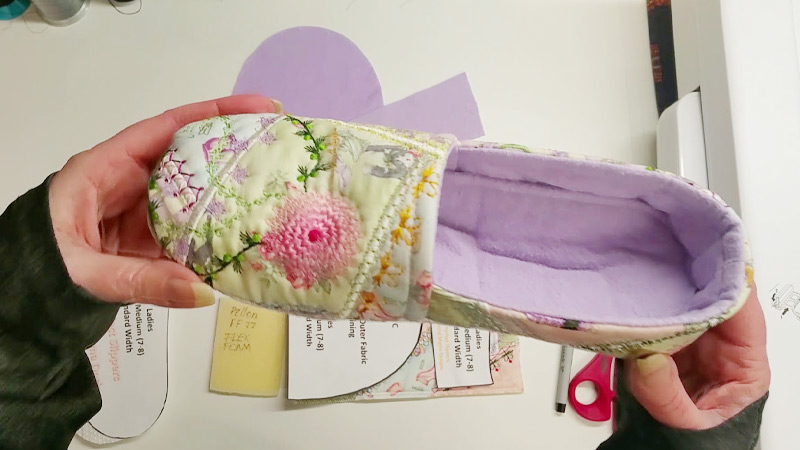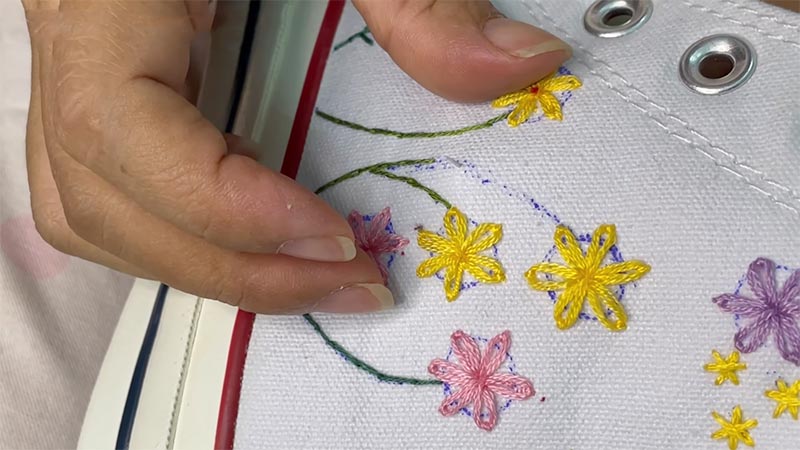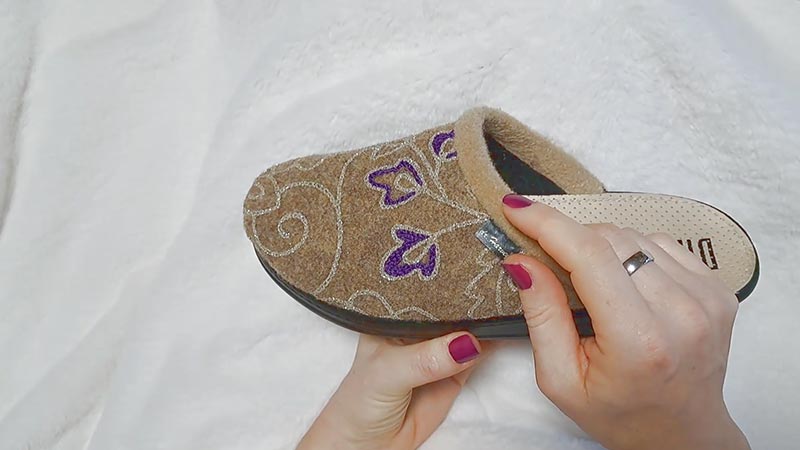Embroidering slippers is a delightful craft that marries comfort with creativity. It’s a way to infuse your footwear with personality and style, transforming mundane slippers into personalized works of art.
This art form isn’t limited to a particular type of slipper; you can embroider anything from plush bedroom slippers to casual everyday wear.
By selecting a design that resonates with you or the recipient, gathering the right materials, and employing various embroidery techniques, you can craft a pair of slippers that not only keep your feet cozy but also make a unique fashion statement.
In this exploration of slipper embroidery, we’ll delve into the step-by-step process of customizing your footwear, giving life to your ideas, one stitch at a time.

Can You Embroider Slippers?
Yes, you can absolutely embroider slippers! Embroidering slippers is a creative and fun way to personalize and add a unique touch to a commonly worn footwear item.
Whether you have plain slippers that you want to customize or you’re making your own from scratch, embroidery can be a fantastic way to make them stand out.
Here are some key steps to consider when embroidering slippers:
Choose Your Slippers
When deciding to embroider slippers, the first step is selecting the appropriate pair. You have a wide range of options, from cozy bedroom slippers to everyday flip-flops. Your choice will depend on the intended use and the material of the slippers.
Fluffy, fabric, and canvas slippers are commonly chosen for embroidery due to their versatility. The material and design of the slippers will impact the techniques and materials you’ll use.
Design Selection
The design you choose for your slippers is a crucial aspect of the embroidery process. It’s an opportunity to showcase your creativity and personal style.
Your design can be as simple as a monogram or as intricate as a detailed motif or pattern. Ensure that the design complements the size and shape of your slippers and is a good fit for the embroidery hoop you plan to use.
Gather Supplies
Before you start embroidering, it’s essential to gather all the necessary supplies.
You will need an embroidery hoop to keep the fabric taut while you work, embroidery floss in your chosen colors, embroidery needles that are suitable for your chosen floss and slipper material, and a pair of sharp scissors.
Depending on the slipper material, you may also require stabilizers or interfacing to provide extra support during the embroidery process.
Mark the Design
To ensure that your embroidery stays on track, it’s helpful to mark the chosen design onto your slippers. A water-soluble or heat-erasable fabric marker is ideal for this purpose.
These markings serve as guidelines for your stitches, helping you maintain a consistent and accurate design.
Thread Selection
Choosing the right embroidery floss is essential for achieving the desired effect. You’ll need to select floss that complements the design and the color of your slippers.
Depending on your design and its intricacy, you may opt for thicker or thinner floss. The choice of floss will significantly impact the final appearance of your embroidered slippers.
Embroidery Technique
There are various embroidery techniques to choose from, and the one you select will depend on your design and the look you want to achieve.
For example, a satin stitch is ideal for filling in larger areas, while a backstitch is perfect for creating precise lines and outlines. The texture and characteristics of your slippers will also influence your technique selection.
Embroider Carefully
When you start embroidering, take your time and work carefully. Pay attention to detail, ensuring your stitches are even and secure.
Be patient, especially if you’re working on a more complex design. The success of your embroidered slippers depends on your dedication to precision.
Finishing Touches
After completing the embroidery, it’s essential to secure the thread ends on the inside of the slipper to prevent them from coming loose.
You can tie knots or weave the ends under existing stitches. For added security, you can also apply a small amount of fabric adhesive or clear nail polish to the thread ends.
Final Care
Depending on the type of slippers and the materials you use for embroidery, you may need to take special care when cleaning your customized slippers.
Always check the care instructions for the embroidery floss and the slipper material to ensure that they maintain their quality and appearance over time.
Show Off Your Custom Slippers
Your embroidered slippers are now ready to be enjoyed. Whether they’re a thoughtful gift for someone special or a unique addition to your own wardrobe, these custom creations will undoubtedly stand out.
Consider sharing your custom slippers on social media or in crafting communities to inspire others to explore the world of slipper embroidery.
Pros of Embroidering Your Own Slippers

Embroidering slippers offer a range of enticing advantages for both craft enthusiasts and those seeking customized and unique footwear:
Personalization
One of the primary benefits of slipper embroidery is the opportunity for personalization.
You can choose designs, colors, and patterns that resonate with your style and preferences, making your slippers truly one-of-a-kind.
Creativity
Embroidery is a creative outlet that allows you to express your artistic flair. You can experiment with various stitches and designs, turning a simple pair of slippers into a canvas for your imagination.
Gift-Worthy
Custom-embroidered slippers make fantastic gifts. Whether it’s for a birthday, holiday, or a special occasion, embroidered slippers show thoughtfulness and effort, making them meaningful presents.
Unique Fashion Statement
Embroidered slippers can be a stylish addition to your wardrobe. They allow you to stand out from the crowd and showcase your individuality through your choice of design and color.
Low-Cost DIY Project
Embroidering slippers can be an affordable DIY project. With a few basic supplies like embroidery floss, needles, and a hoop, you can transform an ordinary pair of slippers into something extraordinary without breaking the bank.
Skill Development
Embroidery is a skill that you can learn and develop over time. It provides a sense of accomplishment as you progress from basic stitches to more complex techniques, enhancing your dexterity and creativity.
Therapeutic and Relaxing
Many people find embroidery to be a relaxing and meditative activity. It can be an excellent way to unwind, relieve stress, and take a break from daily routines.
Preservation of Sentimental Items
If you have slippers with sentimental value, such as those passed down from a loved one, you can enhance their significance by embroidering them with special designs or patterns.
Enhanced Durability
Depending on the type of embroidery and materials used, the added stitches can reinforce the fabric of the slippers, potentially increasing their lifespan.
Contribution to Sustainability
Customizing slippers through embroidery can promote sustainability by encouraging the reuse of existing footwear, reducing the need to purchase new items, and minimizing waste.
Community and Social Connections
Embroidery communities and forums offer opportunities to connect with like-minded individuals who share your interest in this craft. You can exchange ideas, tips, and inspiration with others.
Cons of Embroidering Your Own Slippers

While embroidering slippers can be a rewarding and creative endeavor, it’s essential to consider potential drawbacks and challenges associated with this craft.
Here are some of the cons of embroidering slippers:
Time-Consuming
mbroidery can be a time-intensive activity. Achieving intricate and detailed designs on slippers may require hours of work. If you’re seeking a quick and easy DIY project, embroidery might not be the best choice.
Skill and Learning Curve
Embroidery is a skill that requires practice and patience to master. If you’re new to the craft, there may be a steep learning curve, and your initial projects might not meet your expectations in terms of quality.
Materials and Equipment Costs
Acquiring quality embroidery materials and equipment, including floss, needles, hoops, and stabilizers, can add up. These expenses can deter those on a tight budget.
Limited Reversibility
Once you’ve embroidered your slippers, it can be challenging to reverse or correct mistakes. This lack of reversibility may lead to frustration if you make errors in your design.
Fabric Limitations
Not all slipper materials are suitable for embroidery. Slippers made of certain synthetic or very plush materials may not hold stitches well, making the embroidery process challenging.
Cleanliness and Maintenance
Embroidered slippers may require special care when it comes to cleaning. Depending on the embroidery technique and materials used, they may not be machine-washable, making maintenance more time-consuming.
Design Constraints
The size and shape of slippers can limit the complexity and size of your embroidery designs. This means you might have to simplify or adapt your ideas to fit the available space.
Dexterity and Patience
Fine motor skills and a good deal of patience are essential for embroidery. If you struggle with steady hands or lack the patience for meticulous work, you may find the craft frustrating.
Stress on Slippers
The process of securing embroidery stitches, especially if not done correctly, can put stress on the slipper material. Over time, this could lead to wear and tear.
Inconsistent Results
Achieving consistency in your stitching and design can be challenging, especially for beginners. Uneven or mismatched stitches can affect the overall appearance of your embroidered slippers.
Permanence
Once you’ve embroidered your slippers, the design is permanent. This means you need to be sure of your design choices, as you can’t easily change or update the embroidery without significant effort.
Allergy Concerns
For those with allergies to specific embroidery materials (e.g., certain types of threads), working with these materials could cause skin irritation or discomfort.
FAQS
Can you embroider slippers with thick or plush materials?
Yes, it’s possible to embroider slippers with thicker or plush materials, but it can be more challenging.
You may need to adjust your technique and use stabilizers to prevent the stitches from getting lost in the fabric.
What’s the best way to clean embroidered slippers?
Cleaning embroidered slippers depends on the materials used and the embroidery technique. In many cases, spot cleaning or gentle hand washing is recommended to preserve the embroidery.
Can you embroider old or worn-out slippers to give them new life?
Yes, embroidering old or worn-out slippers can be a great way to revamp and add a fresh, personalized touch to your footwear.
Are there special considerations for embroidering kids’ or baby slippers?
When embroidering slippers for kids or babies, it’s crucial to use child-safe materials and avoid any loose threads or embellishments that could pose a choking hazard.
Can I add embroidery to slippers with rubber soles?
While it’s possible to embroider slippers with rubber soles, it can be more challenging due to the thickness and rigidity of the sole.
To Recap
The art of embroidering slippers combines craftsmanship and creativity to personalize and elevate this everyday footwear.
While there are both pros and cons to consider, the journey of adorning slippers with intricate designs or meaningful motifs is a fulfilling one.
Embroidery allows you to make a unique fashion statement, share thoughtful gifts, and engage in a therapeutic and artistic pursuit.
Moreover, it encourages a sustainable approach by revitalizing existing footwear. Through this craft, you transform slippers into wearable canvases that bear your individuality.
So, whether you’re an experienced artisan or a novice, embroidering slippers offers a gratifying pathway to self-expression, artistry, and comfort.
Leave a Reply